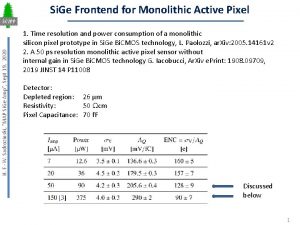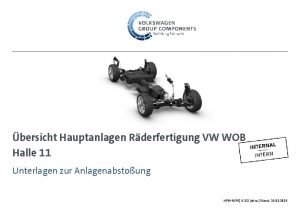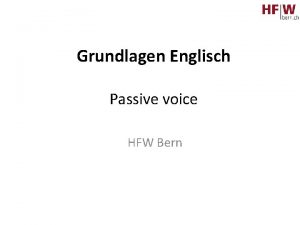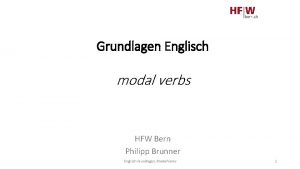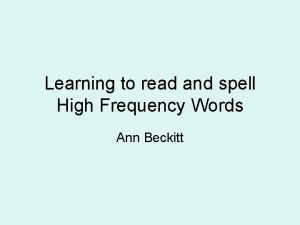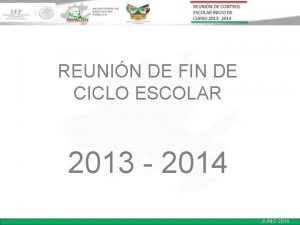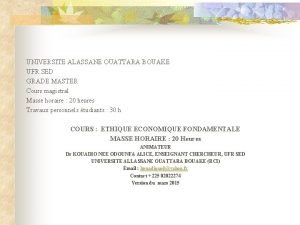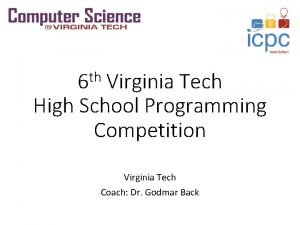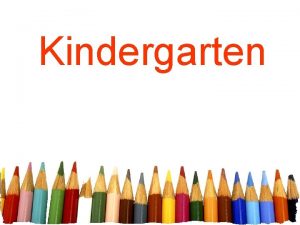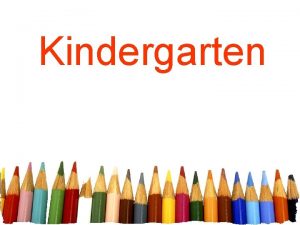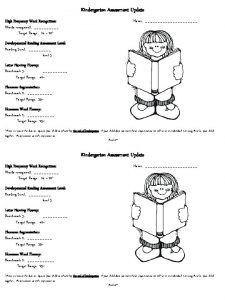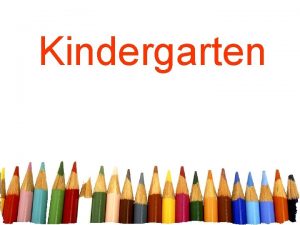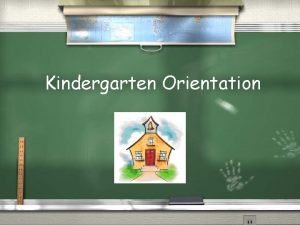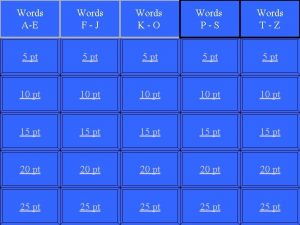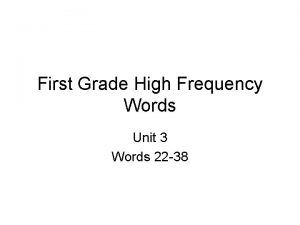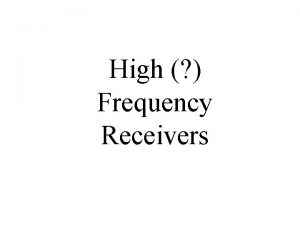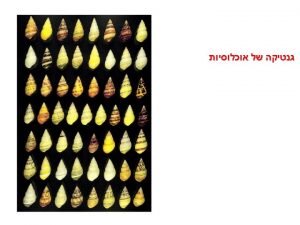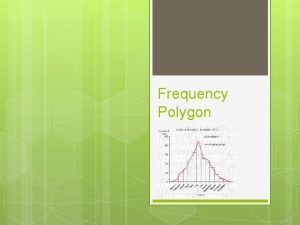Kindergarten 2018 2019 High Frequency Words HFW HFW
















- Slides: 16

Kindergarten 2018 -2019

High Frequency Words (HFW) ▶ ▶ ▶ HFW for the week will be listed on the homework calendar. Most of the words will be provided for you on flash cards. If you lose them or one is missing, please make those at home. Make it fun. Make matching games, have a word hunt, post them on the car seat or window, write them with chalk outside or with bath time crayons on the bath tub. HFW assessments will be done before progress reports and report cards students will need to read them to the teacher from the paper in 3 seconds. HFW are words that need to be memorized and not sounded out.

Behavior ◦ PBIS School-wide behavior plan ◦ Dojo will be used to communicate behavior. Please be sure to sign up and check daily. Weekly and grading period rewards and celebrations will be given to students meeting the percentage goal. ◦ Students can also earn feathers during transitions in the school and common areas to promote positive behavior. The feathers will go into a weekly drawing for prizes/rewards. ◦ Parent contact may be made to reinforce parent/teacher communication with the student and to discuss specific situations.

Common Core ELA Key Ideas and Details CCSS. ELA-Literacy. RL. K. 1 With prompting and support, ask and answer questions about key details in a text. CCSS. ELA-Literacy. RL. K. 2 With prompting and support, retell familiar stories, including key details. CCSS. ELA-Literacy. RL. K. 3 With prompting and support, identify characters, settings, and major events in a story. Craft and Structure CCSS. ELA-Literacy. RL. K. 4 Ask and answer questions about unknown words in a text. CCSS. ELA-Literacy. RL. K. 5 Recognize common types of texts (e. g. , storybooks, poems). CCSS. ELA-Literacy. RL. K. 6 With prompting and support, name the author and illustrator of a story and define the role of each in telling the story. Integration of Knowledge and Ideas CCSS. ELA-Literacy. RL. K. 7 With prompting and support, describe the relationship between illustrations and the story in which they appear (e. g. , what moment in a story an illustration depicts). (RL. K. 8 not applicable to literature) CCSS. ELA-Literacy. RL. K. 9 With prompting and support, compare and contrast the adventures and experiences of characters in familiar stories. Range of Reading and Level of Text Complexity CCSS. ELA-Literacy. RL. K. 10 Actively engage in group reading activities with purpose and understanding.

Informational Text ▶ ▶ ▶ ▶ Key Ideas and Details CCSS. ELA-Literacy. RI. K. 1 With prompting and support, ask and answer questions about key details in a text. CCSS. ELA-Literacy. RI. K. 2 With prompting and support, identify the main topic and retell key details of a text. CCSS. ELA-Literacy. RI. K. 3 With prompting and support, describe the connection between two individuals, events, ideas, or pieces of information in a text. Craft and Structure CCSS. ELA-Literacy. RI. K. 4 With prompting and support, ask and answer questions about unknown words in a text. CCSS. ELA-Literacy. RI. K. 5 Identify the front cover, back cover, and title page of a book. CCSS. ELA-Literacy. RI. K. 6 Name the author and illustrator of a text and define the role of each in presenting the ideas or information in a text. Integration of Knowledge and Ideas CCSS. ELA-Literacy. RI. K. 7 With prompting and support, describe the relationship between illustrations and the text in which they appear (e. g. , what person, place, thing, or idea in the text an illustration depicts). CCSS. ELA-Literacy. RI. K. 8 With prompting and support, identify the reasons an author gives to support points in a text. CCSS. ELA-Literacy. RI. K. 9 With prompting and support, identify basic similarities in and differences between two texts on the same topic (e. g. , in illustrations, descriptions, or procedures). Range of Reading and Level of Text Complexity CCSS. ELA-Literacy. RI. K. 10 Actively engage in group reading activities with purpose and understanding.

Foundation Skills Print Concepts CCSS. ELA-Literacy. RF. K. 1 Demonstrate understanding of the organization and basic features of print. CCSS. ELA-Literacy. RF. K. 1 a Follow words from left to right, top to bottom, and page by page. CCSS. ELA-Literacy. RF. K. 1 b Recognize that spoken words are represented in written language by specific sequences of letters. CCSS. ELA-Literacy. RF. K. 1 c Understand that words are separated by spaces in print. CCSS. ELA-Literacy. RF. K. 1 d Recognize and name all upper- and lowercase letters of the alphabet. Phonological Awareness CCSS. ELA-Literacy. RF. K. 2 Demonstrate understanding of spoken words, syllables, and sounds (phonemes). CCSS. ELA-Literacy. RF. K. 2 a Recognize and produce rhyming words. CCSS. ELA-Literacy. RF. K. 2 b Count, pronounce, blend, and segment syllables in spoken words. CCSS. ELA-Literacy. RF. K. 2 c Blend and segment onsets and rimes of single-syllable spoken words. CCSS. ELA-Literacy. RF. K. 2 d Isolate and pronounce the initial, medial vowel, and final sounds (phonemes) in three-phoneme (consonant-vowel-consonant, or CVC) words. 1 (This does not include CVCs ending with /l/, /r/, or /x/. ) CCSS. ELA-Literacy. RF. K. 2 e Add or substitute individual sounds (phonemes) in simple, one-syllable words to make new words. Phonics and Word Recognition CCSS. ELA-Literacy. RF. K. 3 Know and apply grade-level phonics and word analysis skills in decoding words. CCSS. ELA-Literacy. RF. K. 3 a Demonstrate basic knowledge of one-to-one letter-sound correspondences by producing the primary sound or many of the most frequent sounds for each consonant. CCSS. ELA-Literacy. RF. K. 3 b Associate the long and short sounds with the common spellings (graphemes) for the five major vowels. CCSS. ELA-Literacy. RF. K. 3 c Read common high-frequency words by sight (e. g. , the, of, to, you, she, my, is, are, does). CCSS. ELA-Literacy. RF. K. 3 d Distinguish between similarly spelled words by identifying the sounds of the letters that differ. Fluency CCSS. ELA-Literacy. RF. K. 4 Read emergent-reader texts with purpose and understanding.

Writing ▶ ▶ ▶ Text Types and Purposes CCSS. ELA-Literacy. W. K. 1 Use a combination of drawing, dictating, and writing to compose opinion pieces in which they tell a reader the topic or the name of the book they are writing about and state an opinion or preference about the topic or book (e. g. , My favorite book is. . . ). CCSS. ELA-Literacy. W. K. 2 Use a combination of drawing, dictating, and writing to compose informative/explanatory texts in which they name what they are writing about and supply some information about the topic. CCSS. ELA-Literacy. W. K. 3 Use a combination of drawing, dictating, and writing to narrate a single event or several loosely linked events, tell about the events in the order in which they occurred, and provide a reaction to what happened. Production and Distribution of Writing (W. K. 4 begins in grade 3) CCSS. ELA-Literacy. W. K. 5 With guidance and support from adults, respond to questions and suggestions from peers and add details to strengthen writing as needed. CCSS. ELA-Literacy. W. K. 6 With guidance and support from adults, explore a variety of digital tools to produce and publish writing, including in collaboration with peers. Research to Build and Present Knowledge CCSS. ELA-Literacy. W. K. 7 Participate in shared research and writing projects (e. g. , explore a number of books by a favorite author and express opinions about them). CCSS. ELA-Literacy. W. K. 8 With guidance and support from adults, recall information from experiences or gather information from provided sources to answer a question. (W. K. 9 begins in grade 4)

Speaking and Listening ▶ ▶ Comprehension and Collaboration CCSS. ELA-Literacy. SL. K. 1 Participate in collaborative conversations with diverse partners aboutkindergarten topics and texts with peers and adults in small and larger groups. ◦ ◦ ▶ ▶ ▶ CCSS. ELA-Literacy. SL. K. 1 a Follow agreed-upon rules for discussions (e. g. , listening to others and taking turns speaking about the topics and texts under discussion). CCSS. ELA-Literacy. SL. K. 1 b Continue a conversation through multiple exchanges. CCSS. ELA-Literacy. SL. K. 2 Confirm understanding of a text read aloud or information presented orally or through other media by asking and answering questions about key details and requesting clarification if something is not understood. CCSS. ELA-Literacy. SL. K. 3 Ask and answer questions in order to seek help, get information, or clarify something that is not understood. Presentation of Knowledge and Ideas CCSS. ELA-Literacy. SL. K. 4 Describe familiar people, places, things, and events and, with prompting and support, provide additional detail. CCSS. ELA-Literacy. SL. K. 5 Add drawings or other visual displays to descriptions as desired to provide additional detail. CCSS. ELA-Literacy. SL. K. 6 Speak audibly and express thoughts, feelings, and ideas clearly.

Language ▶ ▶ Conventions of Standard English CCSS. ELA-Literacy. L. K. 1 Demonstrate command of the conventions of standard English grammar and usage when writing or speaking. ◦ ◦ ◦ ▶ CCSS. ELA-Literacy. L. K. 2 Demonstrate command of the conventions of standard English capitalization, punctuation, and spelling when writing. ◦ ◦ ▶ ▶ CCSS. ELA-Literacy. L. K. 4 a Identify new meanings for familiar words and apply them accurately (e. g. , knowing duck is a bird and learning the verb to duck). CCSS. ELA-Literacy. L. K. 4 b Use the most frequently occurring inflections and affixes (e. g. , -ed, -s, re-, un-, pre-, -ful, -less) as a clue to the meaning of an unknown word. CCSS. ELA-Literacy. L. K. 5 With guidance and support from adults, explore word relationships and nuances in word meanings. ◦ ◦ ▶ CCSS. ELA-Literacy. L. K. 2 a Capitalize the first word in a sentence and the pronoun I CCSS. ELA-Literacy. L. K. 2 b Recognize and name end punctuation. CCSS. ELA-Literacy. L. K. 2 c Write a letter or letters for most consonant and short-vowel sounds (phonemes). CCSS. ELA-Literacy. L. K. 2 d Spell simple words phonetically, drawing on knowledge of sound-letter relationships. Knowledge of Language (L. K. 3 begins in grade 2) Vocabulary Acquisition and Use CCSS. ELA-Literacy. L. K. 4 Determine or clarify the meaning of unknown and multiple-meaning words and phrases based on kindergarten reading and content. ◦ ◦ ▶ CCSS. ELA-Literacy. L. K. 1 a Print many upper- and lowercase letters. CCSS. ELA-Literacy. L. K. 1 b Use frequently occurring nouns and verbs. CCSS. ELA-Literacy. L. K. 1 c Form regular plural nouns orally by adding /s/ or /es/ (e. g. , dog, dogs; wish, wishes). CCSS. ELA-Literacy. L. K. 1 d Understand use question words (interrogatives) (e. g. , who, what, where, when, why, how). CCSS. ELA-Literacy. L. K. 1 e Use the most frequently occurring prepositions (e. g. , to, from, in, out, on, off, for, of, by, with). CCSS. ELA-Literacy. L. K. 1 f Produce and expand complete sentences in shared language activities. CCSS. ELA-Literacy. L. K. 5 a Sort common objects into categories (e. g. , shapes, foods) to gain a sense of the concepts the categories represent. CCSS. ELA-Literacy. L. K. 5 b Demonstrate understanding of frequently occurring verbs and adjectives by relating them to their opposites (antonyms). CCSS. ELA-Literacy. L. K. 5 c Identify real-life connections between words and their use (e. g. , note places at school that are colorful). CCSS. ELA-Literacy. L. K. 5 d Distinguish shades of meaning among verbs describing the same general action (e. g. , walk, march, strut, prance) by acting out the meanings. CCSS. ELA-Literacy. L. K. 6 Use words and phrases acquired through conversations, reading and being read to, and responding to texts.

Numbers ▶ ▶ ▶ Know number names and the count sequence. CCSS. Math. Content. K. CC. A. 1 Count to 100 by ones and by tens. CCSS. Math. Content. K. CC. A. 2 Count forward beginning from a given number within the known sequence (instead of having to begin at 1). CCSS. Math. Content. K. CC. A. 3 Write numbers from 0 to 20. Represent a number of objects with a written numeral 020 (with 0 representing a count of no objects). Count to tell the number of objects. CCSS. Math. Content. K. CC. B. 4 Understand the relationship between numbers and quantities; connect counting to cardinality. ◦ ◦ ◦ ▶ ▶ CCSS. Math. Content. K. CC. B. 4 a When counting objects, say the number names in the standard order, pairing each object with one and only one number name and each number name with one and only one object. CCSS. Math. Content. K. CC. B. 4 b Understand that the last number name said tells the number of objects counted. The number of objects is the same regardless of their arrangement or the order in which they were counted. CCSS. Math. Content. K. CC. B. 4 c Understand that each successive number name refers to a quantity that is one larger. CCSS. Math. Content. K. CC. B. 5 Count to answer “how many? ” questions about as many as 20 things arranged in a line, a rectangular array, or a circle, or as many as 10 things in a scattered configuration; given a number from 1– 20, count out that many objects. Compare numbers. CCSS. Math. Content. K. CC. C. 6 Identify whether the number of objects in one group is greater than, less than, or equal to the number of objects in another group, e. g. , by using matching and counting strategies. 1 CCSS. Math. Content. K. CC. C. 7 Compare two numbers between 1 and 10 presented as written numerals.

Operations and Alegbra ▶ ▶ ▶ Understand addition, and understand subtraction. CCSS. Math. Content. K. OA. A. 1 Represent addition and subtraction with objects, fingers, mental images, drawings 1, sounds (e. g. , claps), acting out situations, verbal explanations, expressions, or equations. CCSS. Math. Content. K. OA. A. 2 Solve addition and subtraction word problems, and add and subtract within 10, e. g. , by using objects or drawings to represent the problem. CCSS. Math. Content. K. OA. A. 3 Decompose numbers less than or equal to 10 into pairs in more than one way, e. g. , by using objects or drawings, and record each decomposition by a drawing or equation (e. g. , 5 = 2 + 3 and 5 = 4 + 1). CCSS. Math. Content. K. OA. A. 4 For any number from 1 to 9, find the number that makes 10 when added to the given number, e. g. , by using objects or drawings, and record the answer with a drawing or equation. CCSS. Math. Content. K. OA. A. 5 Fluently add and subtract within 5.

Place Value and operations ▶ ▶ Work with numbers 11 -19 to gain foundations for place value. CCSS. Math. Content. K. NBT. A. 1 Compose and decompose numbers from 11 to 19 into ten ones and some further ones, e. g. , by using objects or drawings, and record each composition or decomposition by a drawing or equation (such as 18 = 10 + 8); understand that these numbers are composed of ten ones and one, two, three, four, five, six, seven, eight, or nine ones.

Measurement and Data ▶ ▶ ▶ Describe and compare measurable attributes. CCSS. Math. Content. K. MD. A. 1 Describe measurable attributes of objects, such as length or weight. Describe several measurable attributes of a single object. CCSS. Math. Content. K. MD. A. 2 Directly compare two objects with a measurable attribute in common, to see which object has “more of”/“less of” the attribute, and describe the difference. For example, directly compare the heights of two children and describe one child as taller/shorter. Classify objects and count the number of objects in each category. CCSS. Math. Content. K. MD. B. 3 Classify objects into given categories; count the numbers of objects in each category and sort the categories by count. 1

Geometry ▶ ▶ ▶ ▶ Identify and describe shapes. CCSS. Math. Content. K. G. A. 1 Describe objects in the environment using names of shapes, and describe the relative positions of these objects using terms such as above, below, beside, in front of, behind, and next to. CCSS. Math. Content. K. G. A. 2 Correctly name shapes regardless of their orientations or overall size. CCSS. Math. Content. K. G. A. 3 Identify shapes as two-dimensional (lying in a plane, “flat”) or threedimensional (“solid”). Analyze, compare, create, and compose shapes. CCSS. Math. Content. K. G. B. 4 Analyze and compare two- and three-dimensional shapes, in different sizes and orientations, using informal language to describe their similarities, differences, parts (e. g. , number of sides and vertices/“corners”) and other attributes (e. g. , having sides of equal length). CCSS. Math. Content. K. G. B. 5 Model shapes in the world by building shapes from components (e. g. , sticks and clay balls) and drawing shapes. CCSS. Math. Content. K. G. B. 6 Compose simple shapes to form larger shapes. For example, “Can you join these two triangles with full sides touching to make a rectangle ? ”

Assessments ▶ ▶ ▶ Students may use computers/laptops/i. Pads to take some assessments this year. I will assess your child’s reading level and comprehension on an i. Pad. Please be sure to complete and return all forms giving permission and agreeing to use technology at school!

Updates ▶ ▶ ▶ ▶ Community Walk in October Agenda and homework folder come back and forth daily. Students also earn a treat/reward for returning Progress Reports/Report Cards and other important papers when returned the next day. Pencil boxes, supplies and change of clothes stay at school Please return decodable books in the zipper baggies. Transportation tags should stay attached to your child’s backpack for safety. Please be sure they remain in tact on the backpacks. Any questions or concerns?
 Hfw map
Hfw map Hfw-wob
Hfw-wob Active voice
Active voice Modal verbs
Modal verbs Rosie ng hfw
Rosie ng hfw High frequency words
High frequency words B a f c j e
B a f c j e Conest hidalgo
Conest hidalgo Resultat ufr sed 2018-2019
Resultat ufr sed 2018-2019 Conditional relative frequency example
Conditional relative frequency example How to calculate relative frequency
How to calculate relative frequency Peak factor formula
Peak factor formula Vmax=aw
Vmax=aw Relative frequency bar chart
Relative frequency bar chart Marginal frequency distribution
Marginal frequency distribution Joint relative frequency vs conditional relative frequency
Joint relative frequency vs conditional relative frequency Virginia tech high school programming contest
Virginia tech high school programming contest
